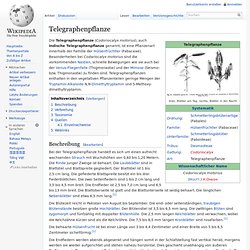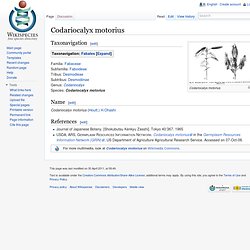

15 Rare, Exotic & Amazing Plant Species. Plants that eat rats, slimy alien-looking fungi, leaves that dance all by themselves and flowers that smell like the rotting corpse of a horse: all of these wonders of nature are among the most rare, exotic and unusual plant species in the world.

Some are astonishingly beautiful despite the foul odors they emit, while others look like they emerged from the mind of a horror writer, but they’re all fascinating examples of the diversity of Earth’s flora. Rat-Eating Pitcher Plant (Nepenthes attenboroughii) (images via: The Guardian, Wikipedia) Even the most benign of pitcher plants is strange and amazing, but the species discovered in August 2009 may just be the weirdest carnivorous plant yet. It’s believed to be the largest meat-eating plant in the world, and is capable of digesting rats. Parachute Flower (Ceropegia woodii) (image via: Wikipedia) Stinkhorn Mushroom (Mutinus Caninus) (images via: Mushroom Expert) Could these be the ugliest fungi ever? Dancing plant desmodium gyrans 跳舞草. Telegraphenpflanze.
Die Telegraphenpflanze (Codoriocalyx motorius), auch Indische Telegraphenpflanze genannt, ist eine Pflanzenart innerhalb der Familie der Hülsenfrüchtler (Fabaceae).

Besonderheiten bei Codariocalyx motorius sind die vorkommenden Nastien, schnelle Bewegungen wie sie auch bei der Venus-Fliegenfalle (Thigmonastie) und der Mimose (Seismo- bzw. Thigmonastie) zu finden sind. Telegraphenpflanzen enthalten in den vegetativen Pflanzenteilen geringe Mengen der Tryptamin-Alkaloide N,N-Dimethyltryptamin und 5-Methoxy-dimethyltryptamin. Beschreibung[Bearbeiten] Die Blütezeit reicht in Pakistan von August bis September. Die behaarte Hülsenfrucht ist bei einer Länge von 3 bis 4,4 Zentimeter und einer Breite von 5 bis 6,5 Zentimeter sichelförmig.[1] Verbreitung[Bearbeiten] Taxonomie[Bearbeiten] Quellen[Bearbeiten] S.
Einzelnachweise[Bearbeiten] ↑ Hochspringen nach: a b c S. Codoriocalyx motorius. Desmodium gyrans - Telegraph Plant. 10 of the World's Strangest Plant Species - Oddee.com (weird plants, strange plants) Welwitschia mirabilis:World's Most Resistant Plant It's not pretty to look at, but Namibia's plant Welwitschia Mirabilis can truly claim to be one of a kind.

There really is nothing like it. Welwitschia plant consists of only two leaves and a sturdy stem with roots. That's all! Two leaves continue to grow until they resemble the shaggy mane of some sci-fi alien. Dionaea muscipula: the Venus Fly Trap The Venus Fly Trap is the most famous of all carnivorous plants due to the active and efficient nature of its unique traps. Rafflesia arnoldii: World's Largest Flower There is one exotic and rare plant you wouldn't likely want to grow anywhere near your landscape no matter how famous it would make you for doing so. Rafflesia Arnoldii, recently assigned to the Euphorbiaceae family, is the biggest individually produced flower in the world.
Its blossoms only last three days to a week. Desmodium gyrans: the Dancing Plant Euphorbia obesa: the Baseball Plant Amorphophallus titanum: the Corpse Flower. Codariocalyx motorius. Codariocalyx motorius (though often placed in Desmodium[1]), known as the telegraph plant or semaphore plant, is a tropical Asian shrub, one of a few plants capable of rapid movement; others include Mimosa pudica and the venus flytrap. It is widely distributed throughout Bangladesh, Bhutan, Cambodia, China, India, Indonesia, Laos, Malaysia, Myanmar, Nepal, Pakistan, Sri Lanka, Taiwan, Thailand and Vietnam. It can even be found on the Society Islands, a remote chain of islands in the South Pacific. It produces small, purple flowers.
Telegraph plant contains small amounts of tryptamine alkaloids in its leaves, stems[verification needed] and roots, namely DMT and 5-MeO-DMT. This plant reproduces using seeds. This plant is famous for its movement of small, lateral leaflets at speeds rapid enough to be perceivable with the naked eye. The Tamils call this plant ThozhukaNNi (Tamil: தொழுகண்ணி). The plant is described in detail in Charles Darwin's 1880 The Power of Movement in Plants. Codariocalyx motorius. Codariocalyx motorius [edit] Familia: Fabaceae Subfamilia: Faboideae Tribus: Desmodieae Subtribus: Desmodiinae Genus: Codariocalyx Species: Codariocalyx motorius Name[edit] Codariocalyx motorius (Houtt.)

H.Ohashi References[edit] Journal of Japanese Botany.